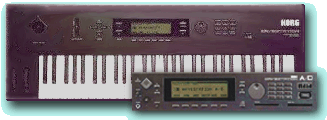
- Korg wavestation sr sounds upgrade#
- Korg wavestation sr sounds full#
- Korg wavestation sr sounds software#
The clip makes it easy to swap out the battery. It was a proper battery clip, and in it, a battery that I had in plentiful supply in my tool closet: The ever-lovin’ CR2032 3-volt battery, which powers all sorts of things, including the CMOS RAM on ThinkPads, which I covered in an earlier article.
Korg wavestation sr sounds full#
I found a pleasant surprise waiting for me on the Wavestation’s main printed circuit board: Tap to view at full size.
Korg wavestation sr sounds upgrade#
This was probably a cost-cutting measure (compared to today’s prices, synths in the ’80s were quite expensive), and manufacturers probably believed that we’d all upgrade to later models long before those batteries died. If you’ve ever had to replace the battery of an early- to mid-1980s synthesizer with battery-backed memory, you’ve probably dealt with the annoyance of that battery being soldered in.

Here’s what it looks like from above: Tap to view at full size. Here’s what the inside looks like, as viewed from the front panel: Tap to view at full size. It’s a pretty simple process where you remove six screws - two on each side, and two on the back. The first step was to pop the top panel from the Wavestation. I’ve done RAM battery replacements on numerous devices over the years, so I felt comfortable with going inside the Wavestation to see how big a chore replacing the battery would be. It had reverted to a copy of the ROM sound on which it was based. I confirmed this theory by tweaking the settings for one of the sounds in RAM, turning the synth off and back on again, then checking my edited sound. I suspected that the battery that maintained the contents of the Wavestation’s RAM had died long ago. I no longer had a synth with 200 sounds (or in Wavestation parlance, “performances”, or in general synth terms, “patches”) - I had four identical banks of 50 sounds: from the Korg Wavestation A/D Performance Notes manual. They had been replaced by copies of the ROM sounds. The bad news, which I was expecting, was that while the built-in sounds in ROM remained, all three RAM banks which held the sounds that I had lovingly created so very long ago were gone. The screen came to life, and pressing keys resulted in those rich Wavestation sounds: Tap to view at full size. With that in mind, I pulled the Wavestation out of its closet, where it had been sitting, plugged in my small MIDI keyboard controller ( the original version of the M-Audio Axiom 25), hooked it up to powered speakers, and turned it on: Those videos will include music, and I thought that while there’s nothing wrong with licensing some music, why not write my own?
Korg wavestation sr sounds software#
One of my plans for this year is to create a series of videos covering software development and other tech topics including security. If you’d like to hear what it sounds like, check out this video by Espen “I am the 80s” Kraft:īringing the Wavestation back to active duty Simply put, the Wavestation is a beautiful-sounding synth, and even 30 years later, it still sounds great. I’ve held onto it ever since, having taken it from Kingston to Toronto, then San Francisco during the dot-com bubble and back, and it’s now at my current home in Tampa. …and I’ve even used it for some multimedia software projects: My first software deliverable after graduating from University: A multimedia promo for family album software.

…and I’ve done other live gigs with it (that’s me in the pink wig)… Stephen Skratt, me, and Karl Mohr jamming on keyboards in 1999. I bought the Wavestation from my friend, Canadian TV/film composer Stephen Skratt, back in 1993, when I was playing keyboards in a band with my schoolmates at Crazy Go Nuts University… Me, circa 1992.

The Wavestation series of synths set itself from the other synths of the era by using a technology called wave sequencing, which could be described as building sounds by pasting sequences of different waveforms together, in a way similar to George Martin’s cut-and-paste approach to the calliope sounds on the Beatles’ Being for the Benefit of Mr. The Korg’s Wavestation A/D is the rack-mount version of the Korg Wavestation EX keyboard synth, which in turn is a revised and expanded model of the original Korg Wavestation. Over the years, I’ve bought and then sold or given away a number of synths, but there’s one that I kept: A Korg Wavestation A/D. Long before I became an accordion player, I was a synth player. The Korg Wavestation A/D The best damned synth of 1991.


 0 kommentar(er)
0 kommentar(er)
